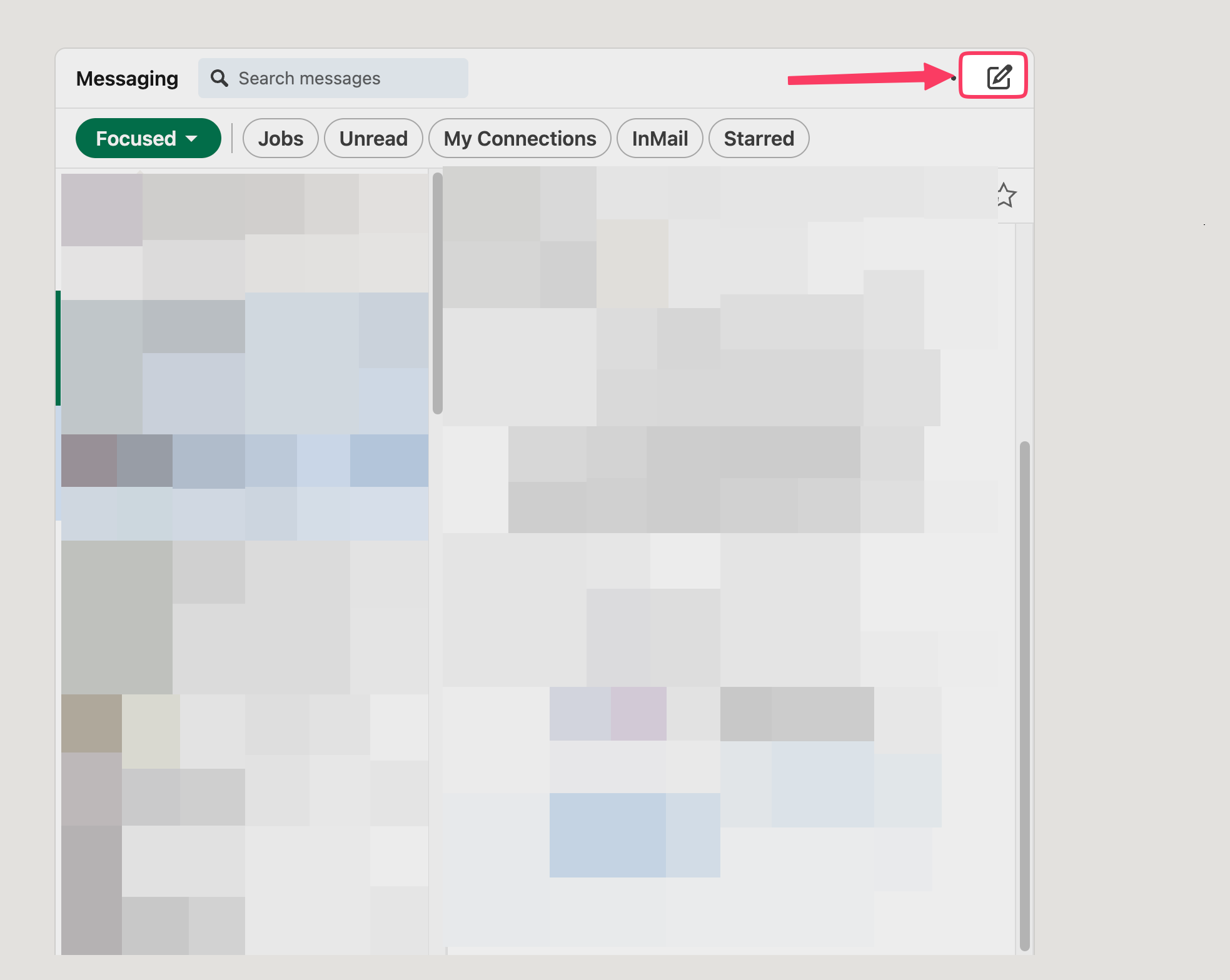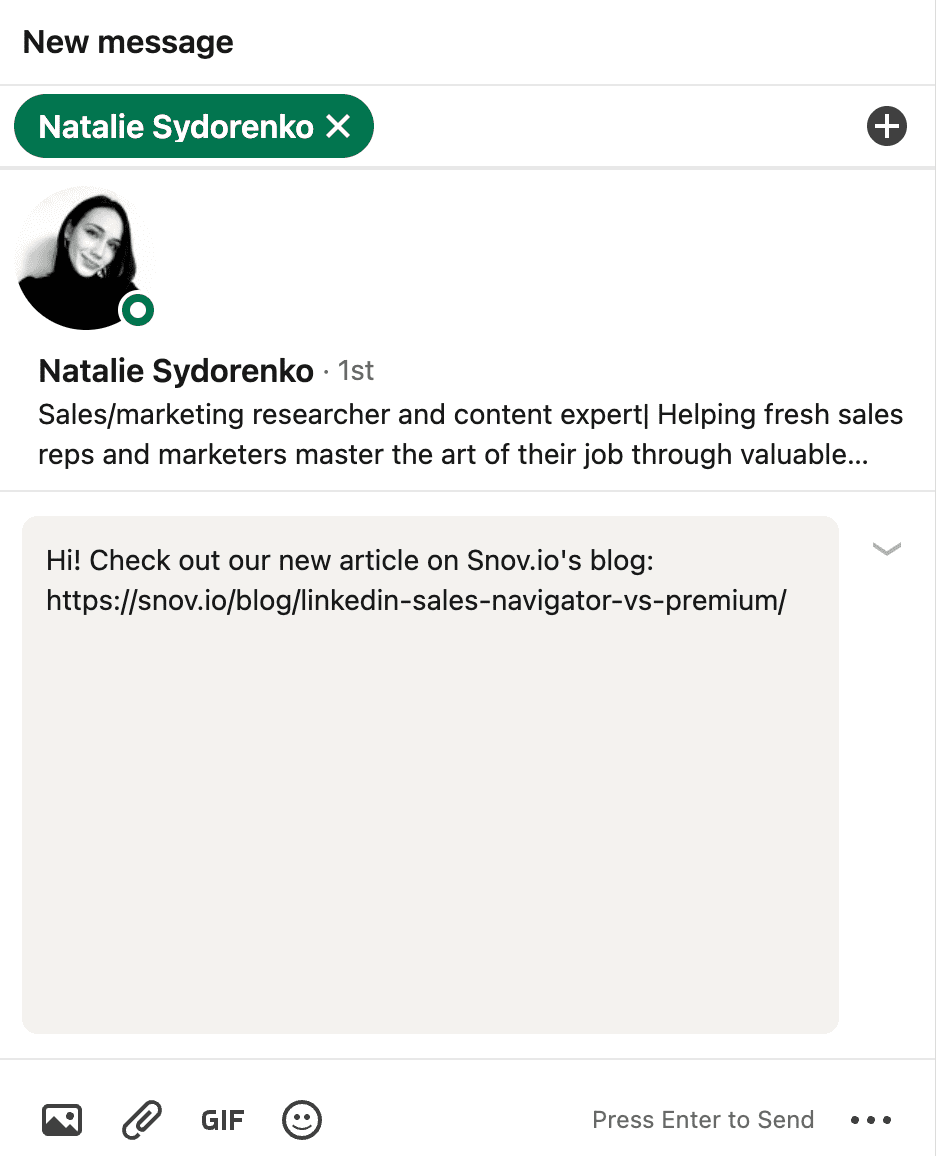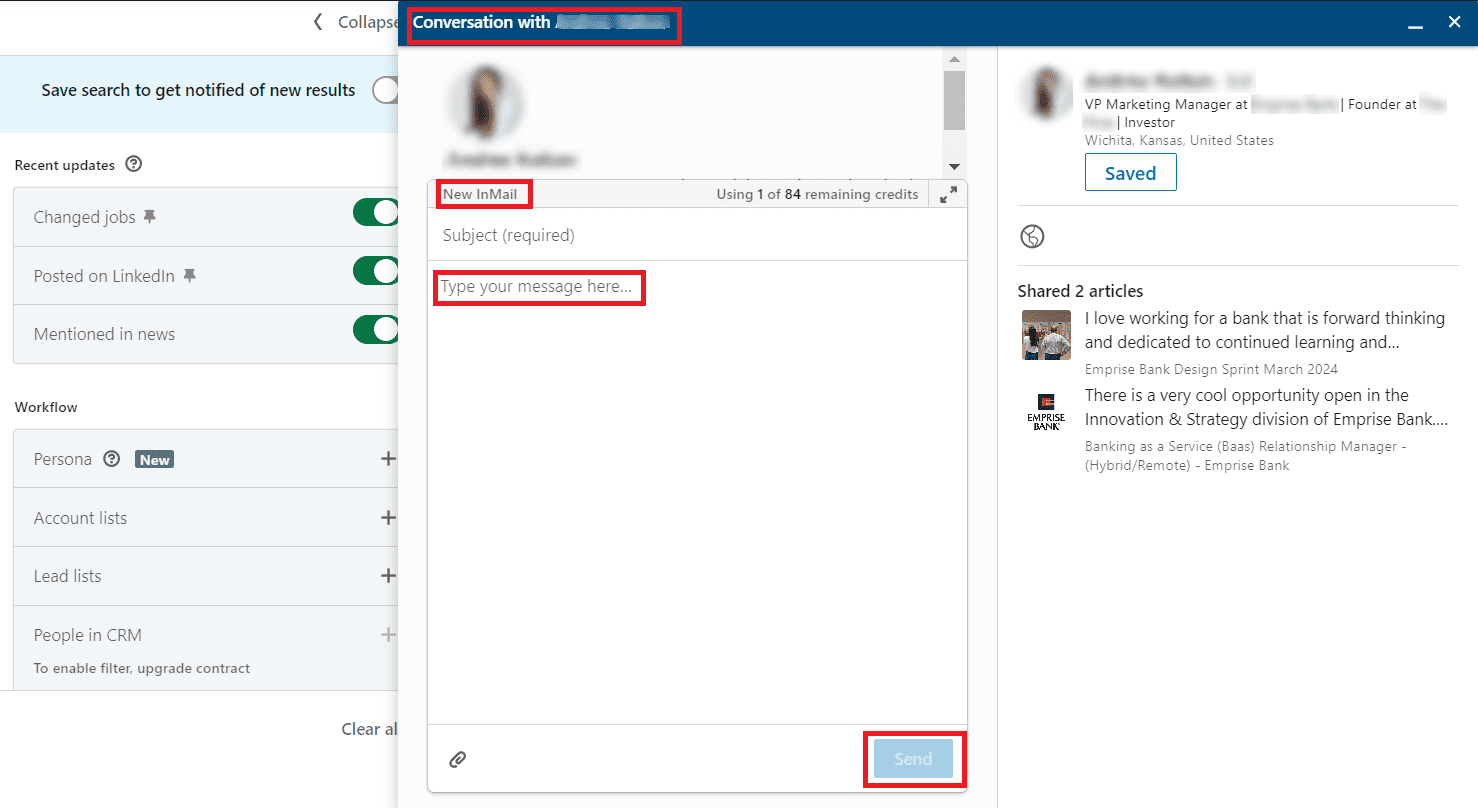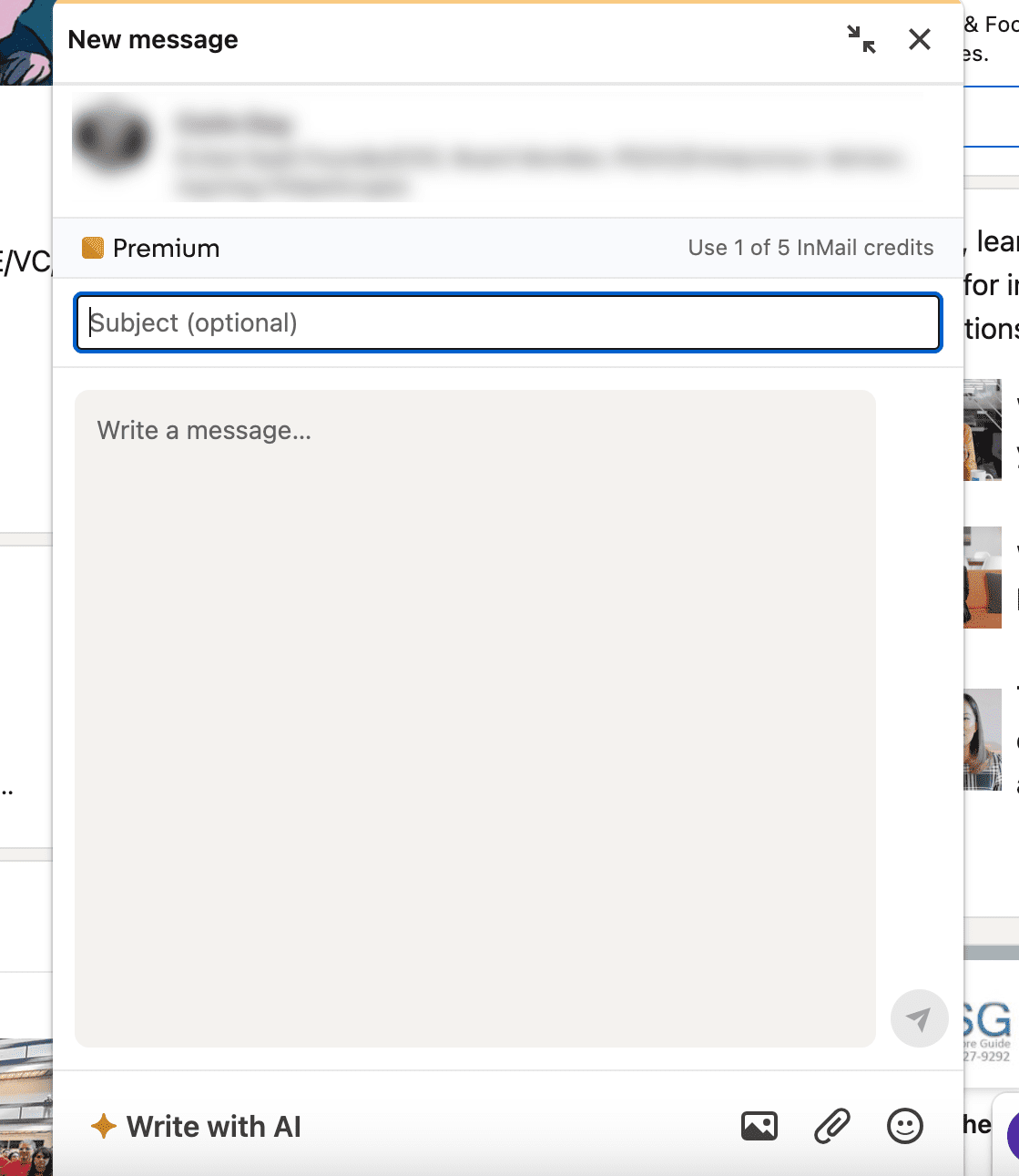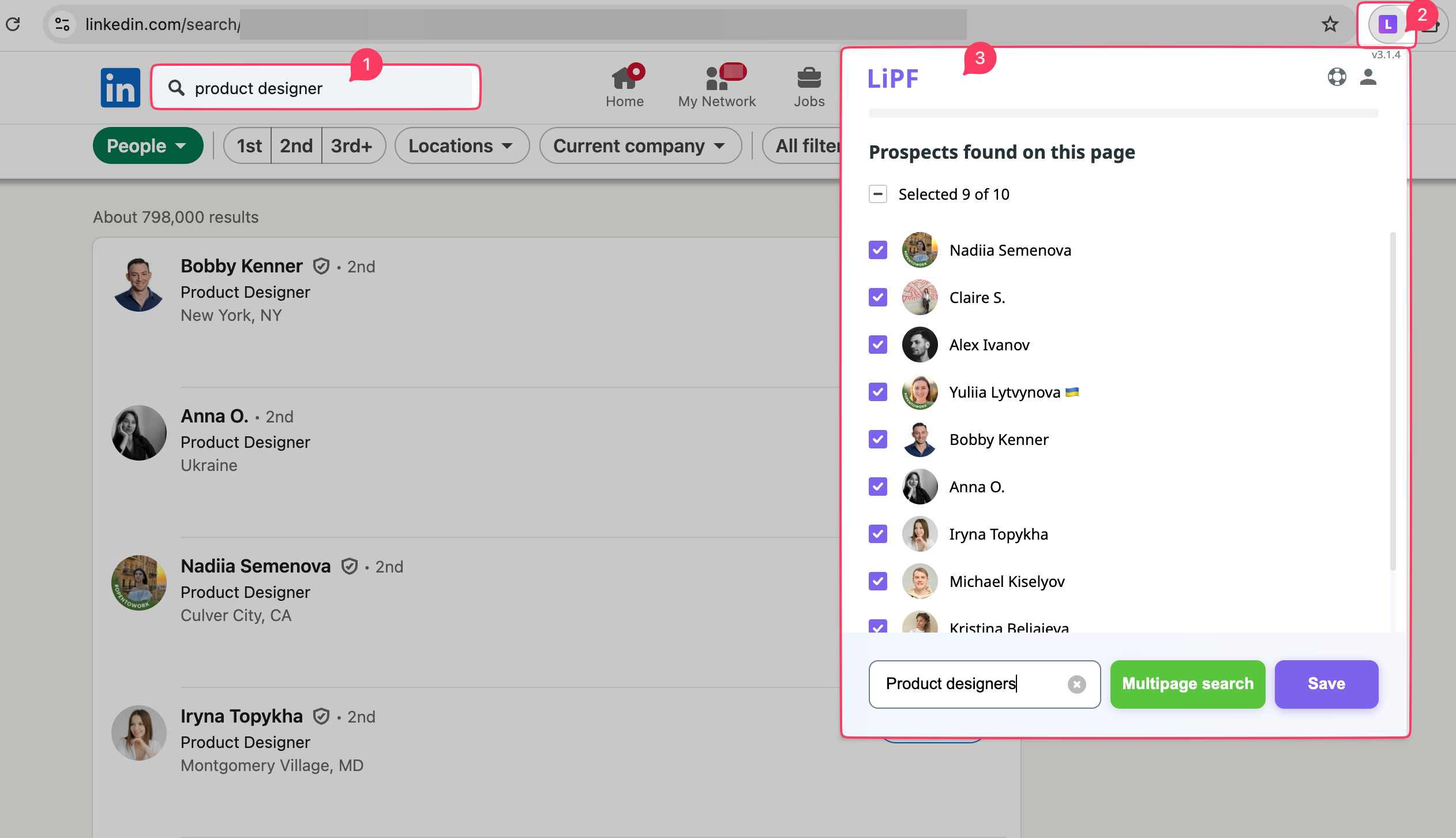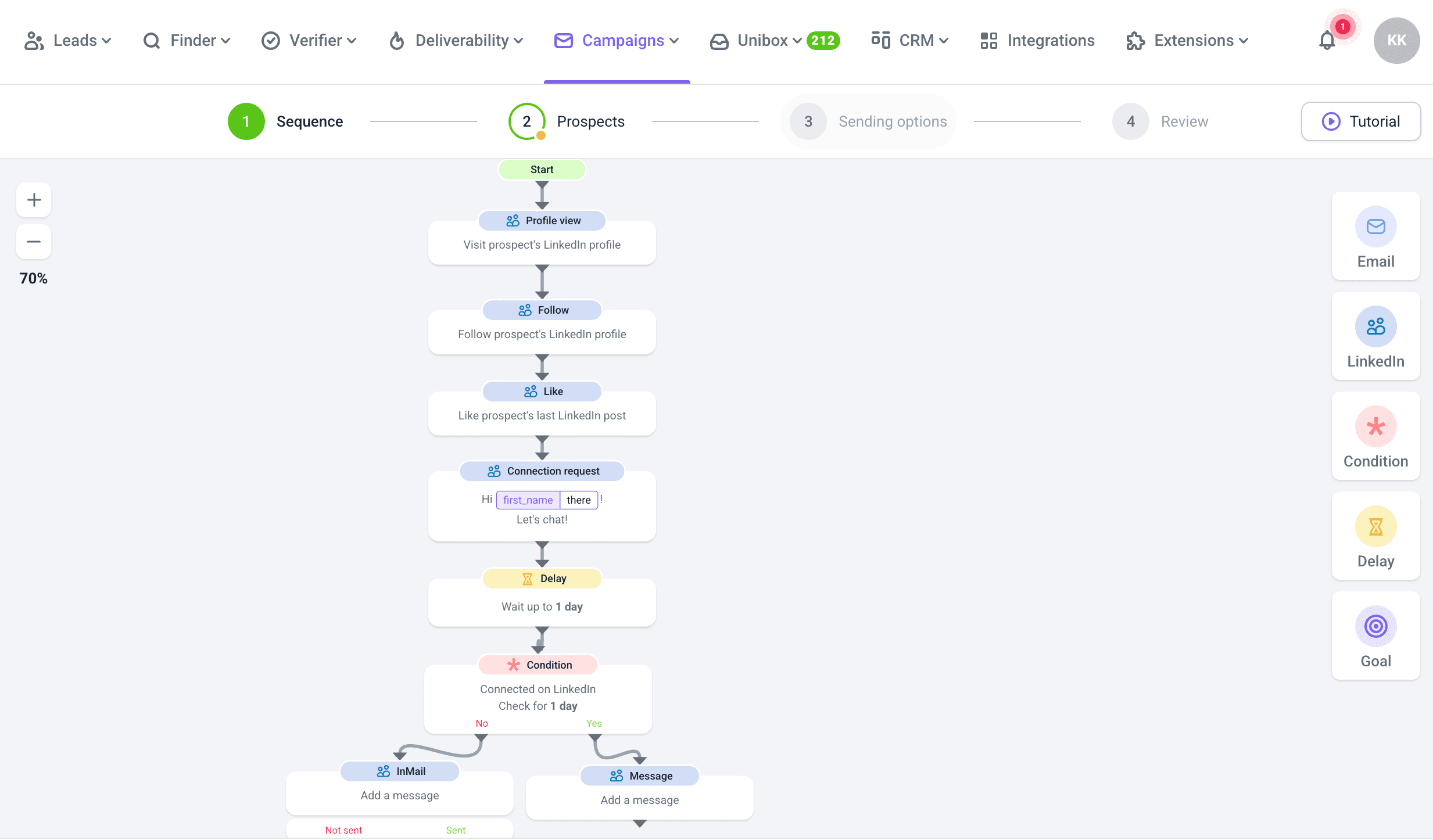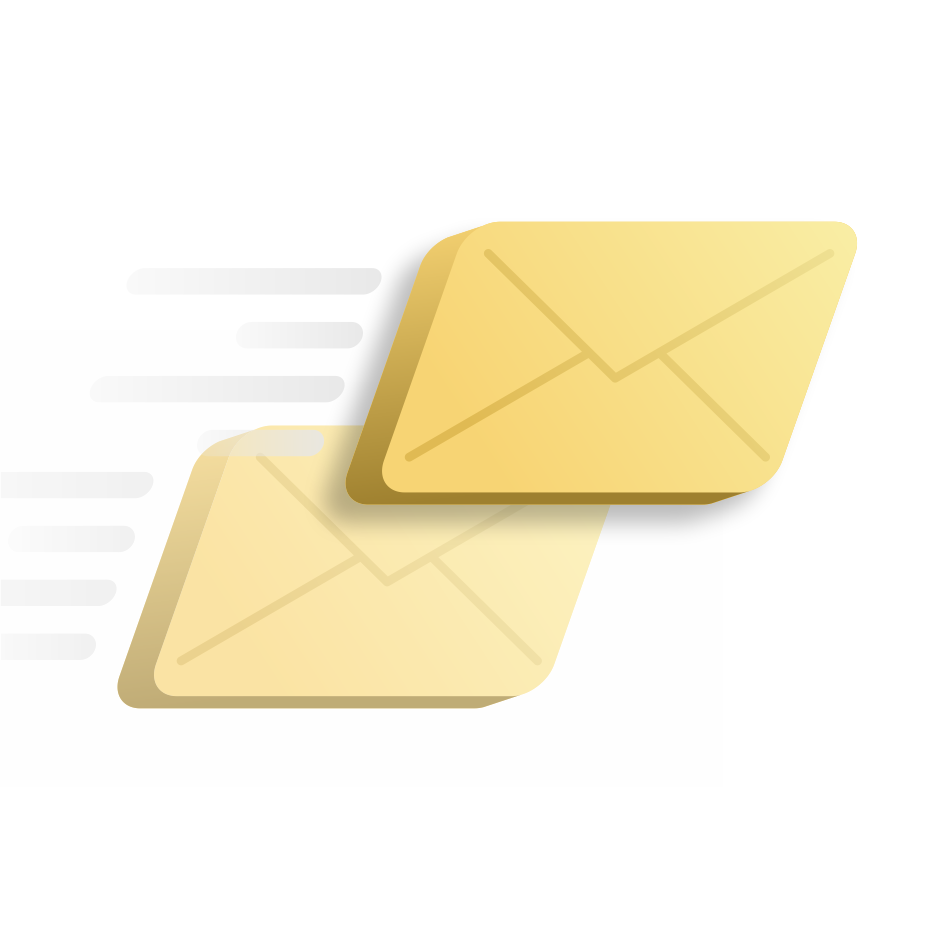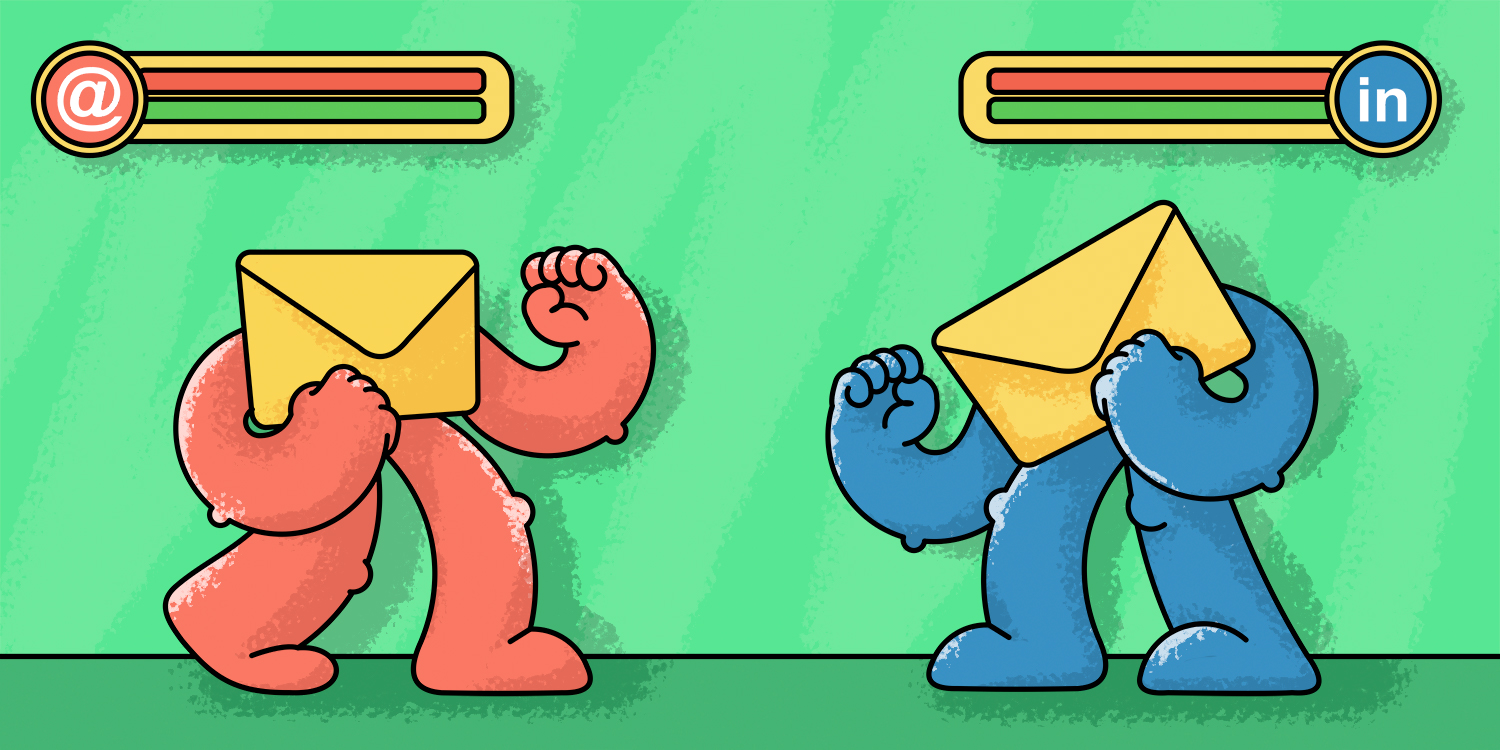TL;DR
The LinkedIn InMail vs Message choice depends on context:
| Feature | LinkedIn Message | InMail |
|---|---|---|
| What does this feature entail? | Standard messaging to 1st-degree connections. | A Premium feature that lets you message non-connections directly. |
| Who can you reach? | 1st-degree connections, some group members, and Premium members with Open Profile enabled. | Any member without prior connection. |
| Requires Premium? | No. | Yes (Sales Navigator, Recruiter, or Premium plans). |
| Subject line | No subject line. | Subject required (up to 200 characters). |
| Cost | Free. | Uses monthly InMail credits (additional credits can be purchased). |
| Sending limits | Not credit-based, but sending too many messages too quickly can get you banned. | Credit-based; plan-specific allotments and daily caps apply. |
| Deliverability & visibility | Goes to the recipient’s LinkedIn inbox if you’re connected (or as a message request otherwise). | Delivered as an InMail with a corresponding note in the inbox. |
| Best for | Nurturing relationships with existing connections; quick follow-ups after a connect. | Cold outreach to targeted non-connections (sales, recruiting, partnerships). |
| Pros | Free, conversational, higher trust with existing connections. | Reaches beyond your network; uses a subject line to frame your intent; allocates more space for context. |
| Cons | Limited reach without a connection, Open Profile, or shared group/event. | Paid feature |
The real LinkedIn InMail vs Message question isn’t just about cost — it’s about timing and context. When the lines get blurred and there’s no clear strategy, poor results are almost guaranteed. The key is matching the tool with the situation.
Let’s break down how to use both correctly in your LinkedIn outreach so you can get more replies and turn them into real conversations.
Outline:
What is a LinkedIn message?
LinkedIn messages are the primary and free way to contact people you’re already connected to on the platform. They can be great for building relationships and just staying top of mind with your network.
How to send a message on LinkedIn?
There are several ways to send a message on LinkedIn:
- From the Messaging page
Click the Messaging icon located at the top of your home page.
Then, click the pencil icon to start a new message.
Type the name(s) of your recipient(s) in the To field and add them. Then, create your message.
Press enter to send.
- From someone’s profile
Go to the profile of your recipient. Click the blue Message button.
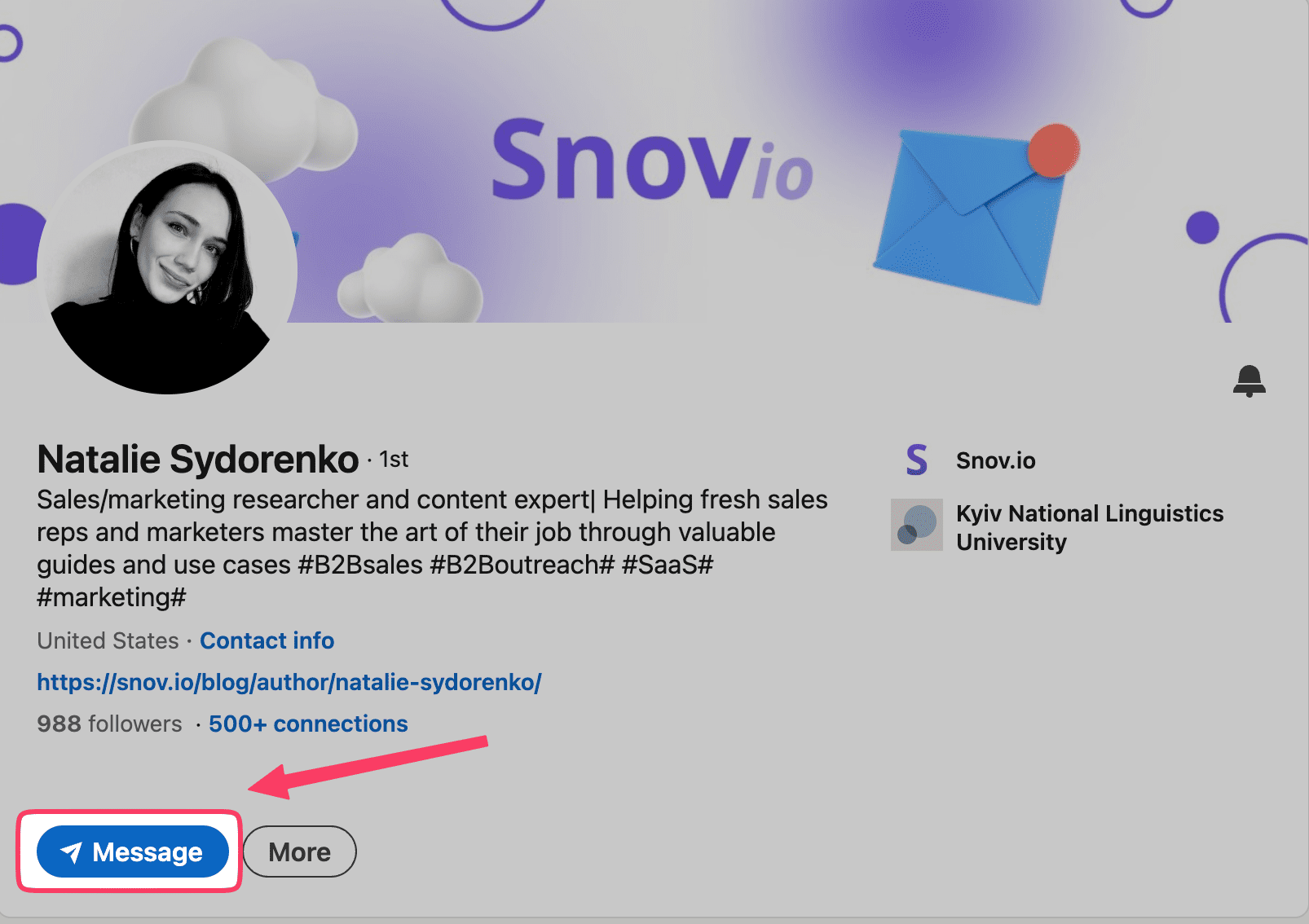
Type your message and press Enter to send it.
You also have options to forward messages and search through your inbox with filters
Who you can reach with LinkedIn messages
By default, you can contact only your 1st-degree connections for free. These are people who either accepted your connection request or vice versa. Their profiles display a “1st” icon to indicate this direct relationship.
Since these people have already shown interest in connecting, they are your warmest contacts. This logically makes it more likely that they will respond and engage in real conversations. Still, not everyone will interact with your LinkedIn lead generation efforts, so it’s important to keep your expectations realistic.
|
💡Expert tip To increase your first-degree connections and gain the ability to message them, start by sending personalized connection requests. But remember that LinkedIn closely monitors activity patterns. At Snov.io, we recommend staying within safe ranges: Safe: around 5-10 requests per day Moderate: about 20-30 requests per day Risky: 40-50 requests per day |
So, when do LinkedIn messages come in handy?
LinkedIn message use cases
LinkedIn messages work best when approached with a solid grasp of the situations where they bring the most value. Smart approaches include:
- Nurture: Engage with their posts regularly and check in from time to time to maintain visibility.
- Follow-ups: After meeting at an event or connecting online, send a quick message to continue the conversation.
- Warm outreach: Share helpful resources or relevant insights before making any requests.
Focusing on these strategies helps ensure your messages feel relevant and increase the likelihood of meaningful responses.
What Is LinkedIn InMail?
LinkedIn InMail is a Premium feature that lets you send messages to people outside your direct network. You can access it with a paid subscription such as LinkedIn Premium, Sales Navigator, or Recruiter Lite. Once upgraded, the platform provides you with a set number of credits every month. But keep in mind that the exact amount depends on your subscription plan:
| Paid account type | Number of credits |
|---|---|
| Premium Career | 5 |
| Premium Business | 15 |
| Sales Navigator | 50 |
| Recruiter Lite | 30 |
How to send an InMail on LinkedIn?
First, secure a Premium subscription (Premium, Sales Navigator, or Recruiter Lite).
Next, go to the profile of the person you’d like to contact.
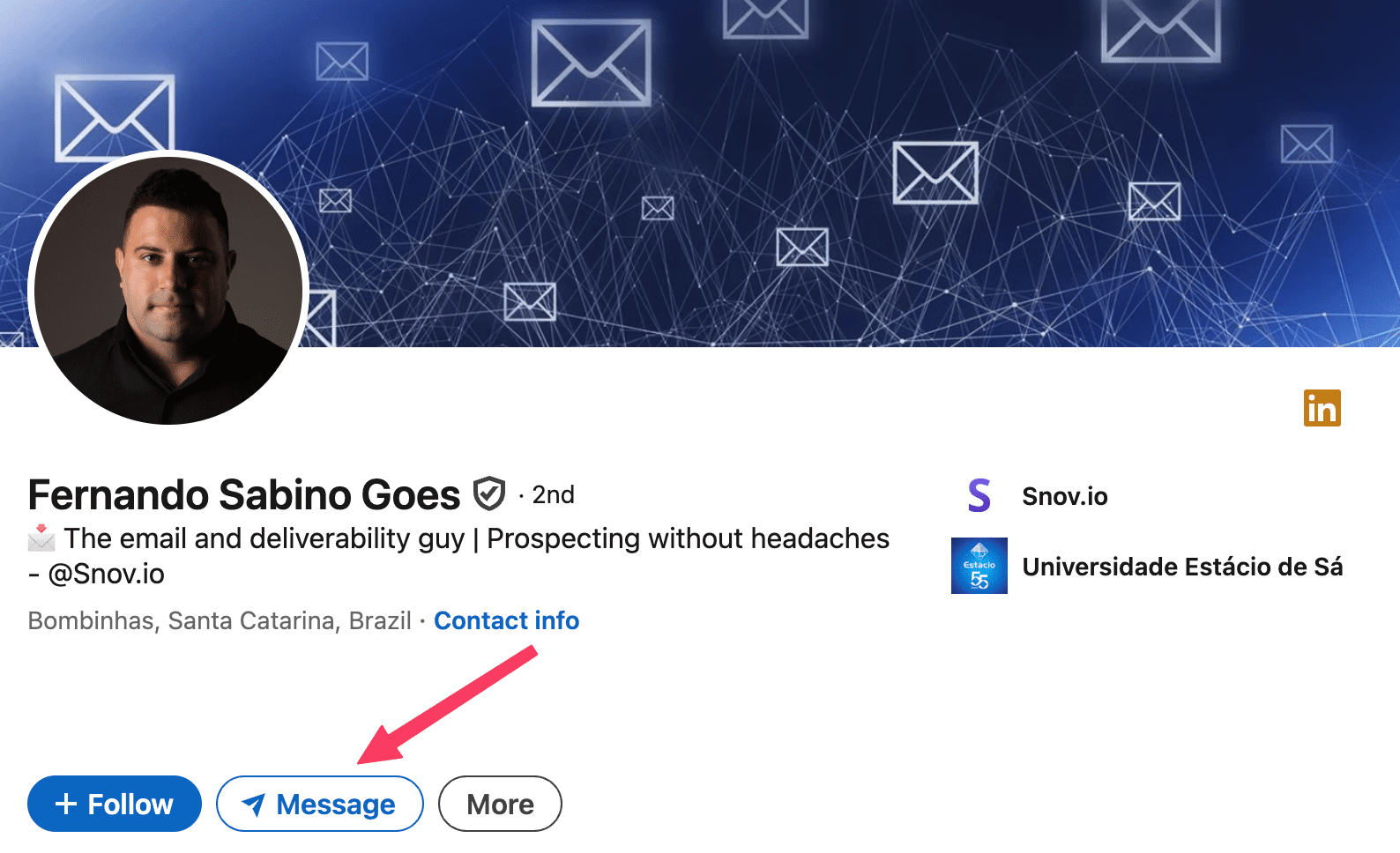
Click Message, and a pop-up window will open.
Write your subject line and main content, and once ready, click Send.
We also highly suggest scaling this process with automation tools. With Snov.io, for example, you can automate InMails, keeping them personal at the same time.
InMail features and limits
If LinkedIn InMails seem like a solid deal for you, then here are a few other things worth keeping in mind:
Length: Each message can be up to 2,000 characters in the body with a 200-character subject line. This gives you more room to tell your story.
Credits: You receive a certain number of InMails each month, depending on your plan.
Credit rollover: Unused credits carry over to the next month.
Earn-back system: If your InMail gets a reply within 90 days, you earn that credit back.
Who can you message with InMail?
InMail lets you reach people who aren’t your direct connections. This includes potential clients, recruiters, hiring managers, or partners. The only limitation is that the recipient must have their InMail preferences enabled. If they’ve opted out, you won’t be able to contact them this way.
💡Bonus tip
If a LinkedIn member has InMails turned off, don’t worry, because you still have options to reach them without Premium. For example, consider using the LinkedIn Email Finder extension, which helps you quickly access users’ email addresses.
Once you have it, you can send a personalized email and continue the conversation outside LinkedIn.
When to use InMail (and when to avoid it)
We recommend using InMail for formal sales introductions or recruitment purposes. Since they appear with an “InMail” label in the inbox, they stand out and come across as more professional.
That being said, this feature may not always be the best solution. They are only available with a Premium subscription, which may not be the best fit for small teams or those new to LinkedIn. Plus, just because you can send an InMail doesn’t mean you’ll get a reply. Many users ignore or disable them.
LinkedIn InMail vs Message: Key differences
Understanding LinkedIn InMail vs Message depends on knowing your target audience and your goals. Both tools have distinct advantages, but they work best in different scenarios.
Visibility and connection level
LinkedIn messages are free and can only be sent to your 1st-degree connections. This makes them more personal and often more effective because the recipients already know who you are.
LinkedIn InMail, on the other hand, removes the connection requirement entirely. You can reach CEOs, industry experts, or potential candidates who aren’t in your network. The limitation is that some users disable this functionality, so your outreach may not reach them, regardless of how well-crafted it is.
Cost-effectiveness and outreach limits
LinkedIn messages are unlimited and free, making them cost-effective and ideal for relationship-building.
InMail messages require a paid subscription, and depending on your plan, you’ll get a limited number of monthly credits (5–50). If someone replies within 90 days, you will earn the credit back; otherwise, it’s gone. This makes InMail more expensive and harder to scale for bulk outreach.
Performance metrics comparison
Here’s how LinkedIn InMail vs Message typically compares in practice:
- Response rates: Messages typically achieve higher response rates due to existing relationship trust. InMail response rates usually range from 10 to 25% when personalized.
- Speed of replies: The platform reports that 65% of InMail replies arrive within 24 hours. Still, it’s reasonable to assume that messages from existing contacts often get answered even faster.
- Scalability: Free messages are unlimited, while InMails are restricted by credits. For volume-based lead generation, this can be a limiting factor.
Overall, both features are valuable, but in different contexts.
Pros and cons of LinkedIn messages
LinkedIn messages are free, unlimited, and highly effective for nurturing existing relationships.
Their strengths include:
- Free and unlimited: No subscription or credit system.
- Higher response rates: Sent to 1st-degree connections who already know you.
- Relationship-focused: Great for nurturing, follow-ups, and ongoing conversations.
- Cost-effective: Scalable outreach without added expenses.
Like any outreach method, LinkedIn messages come with certain drawbacks. The main limitations include:
- Only for 1st-degree connections: You can’t use them to reach new prospects directly.
- Dependent on your network size: Small or untargeted networks limit your results.
- Slower expansion: Building connections takes time before you can message freely.
To overcome this, we recommend combining regular messages with connection requests, InMails, and even email campaigns for a multichannel approach.
When to use LinkedIn InMail vs Messages
Both features help you connect with prospects. But the right choice depends on your outreach goals and the prospect’s stage in the buyer’s journey.
Here’s how to decide which one works best for your outreach and lead generation:
Based on your LinkedIn outreach goal
Use InMails when:
- You need to reach people outside your network, such as executives, hiring managers, or decision-makers.
- You’re running recruitment campaigns and want to approach candidates directly.
- You’re starting formal sales conversations or pitching partnerships with companies you’re not yet connected to.
- You want your Message to stand out with the “InMail” label in the inbox.
Use LinkedIn messages when:
- You’re nurturing your existing 1st-degree connections.
- You want to follow up after events, online meetings, or connection requests.
- You’re sharing insights, updates, or resources to stay top of mind.
- You want to keep your outreach cost-effective and scalable.
We recommend using InMail for targeted, high-value opportunities and LinkedIn messages for relationship-driven communication.
Based on the relationship stage in the buyer journey
LinkedIn InMail is most effective at the early stages of the buyer journey, when you’re introducing yourself to new prospects. It’s a great way to break the ice with people who haven’t yet engaged with you or your content.
LinkedIn messages are more effective in the middle and later stages of the journey. Since these contacts already know you, messages are perfect for:
- Nurturing: engaging with warm leads who are exploring their options.
- Following up: reminding prospects after meetings, demos, or proposals.
- Converting: moving warm contacts closer to becoming paying clients or partners.
We recommend combining both. Use LinkedIn InMail vs Message strategically — former for outreach to new leads, and latter for ongoing relationship-building and conversions. This balanced approach ensures your outreach covers the full buyer journey and drives stronger results in LinkedIn lead generation.
Pros and cons of LinkedIn InMails
With InMails, you can message people outside your direct network. This opens doors to professionals you wouldn’t otherwise reach.
Key advantages include:
- Direct access to decision-makers: Perfect for executives, hiring managers, and high-value leads.
- No connection required: You don’t need the person to accept your request first.
- Inbox visibility: InMails stand out with a special label, making them more noticeable.
- Professional impression: Works well for formal introductions, sales outreach, or recruitment.
Despite the benefits, LinkedIn InMail has important limitations to know:
- Lower reply rates: Recipients are unfamiliar with you, so many ignore your outreach attempts.
- Credit-based system: Limited monthly credits (5–50, depending on plan), which can run out fast.
- Costly: Requires a Premium subscription, making it less budget-friendly.
- Spam risk: If not personalized, InMails may come across as cold sales pitches.
Due to these drawbacks, we recommend using this feature sparingly and pairing it with other outreach methods for optimal results.
How to automate your LinkedIn outreach with Snov.io
Reaching out to prospects manually works well for a few individuals, but it becomes unsustainable when trying to scale. Snov.io bridges this gap by combining LinkedIn activities with email outreach, creating a more comprehensive approach to relationship-building.
Snov.io’s LinkedIn automation handles time-consuming tasks, such as viewing profiles, engaging with posts, following prospects, and sending connection requests or messages. Some of these steps might seem like an afterthought, yet they help build visibility and gently warm up prospects before direct contact.
Personalization is also built in. Using Dynamic fields and Spintax, each message can be tailored so it feels authentic rather than automated.
But the strategic advantage emerges when you integrate LinkedIn with email outreach. This way, if prospects don’t respond there, you can even seamlessly transition the conversation to email.
🖊️ Case study
SpotOn, a company in the hospitality and restaurant sector, faced challenges in collecting contacts and engaging prospects efficiently.
By using Snov.io, they automated their LinkedIn prospecting and combined LinkedIn actions with personalized email outreach.
This approach worked really well. SpotOn ended up getting 40% more potential customers interested in their services. Even better, they closed 18% more actual sales because they could reach more people and follow up consistently.
Our sales revenue has grown by 18% since we started using Snov.io.
Automation & Customer Success Specialist at SpotOn
Key takeaways
Finding the right balance in the LinkedIn InMail vs Message decision is all about strategy. Use messages to strengthen relationships with your 1st-degree connections and save InMails for when you truly need to reach outside your network.
Adding email creates a multichannel approach that reaches prospects wherever they’re active and increases your chances of being noticed. So, try Snov.io to bring this strategy to life.

